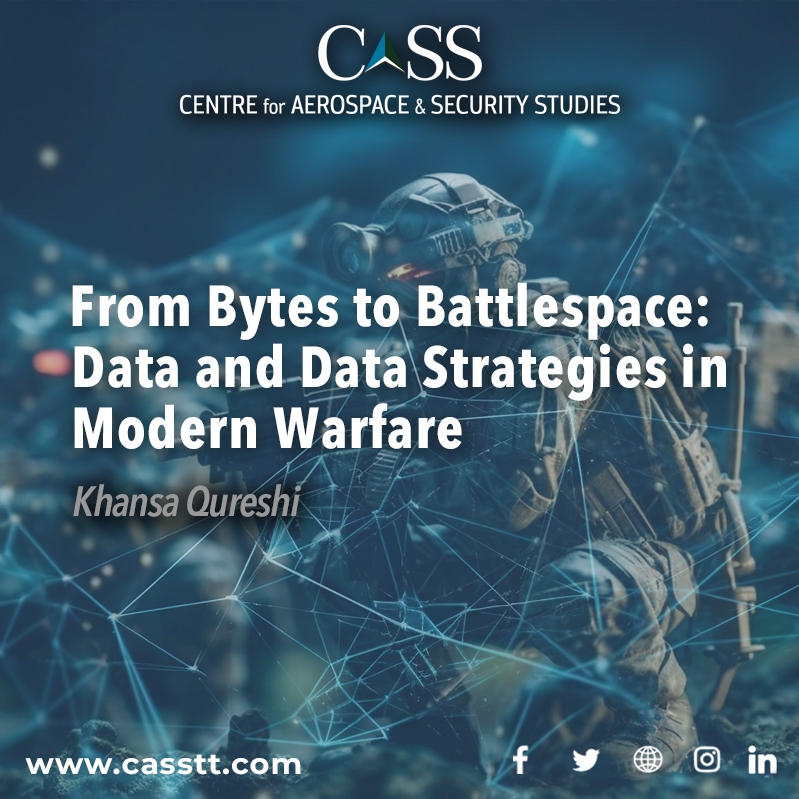For decision-making in the past, military commanders relied heavily upon the simplest analyses of given information such as comparison of own vs enemy’s assets; assessment of enemy’s strengths and weaknesses; knowledge about location of enemy’s forces and strongholds etc. However, given the limitations of human capabilities through which this data was mainly gathered, much of this analysis consisted of fragmented information, leading to incomplete situational awareness and subsequently, to risky decision-making.
This phenomenon changed fundamentally as technological advancements brought about exponential increase in the availability of data. Gradually, the world is getting to the point where militaries across the globe are deploying various disruptive technologies in warfare. This phenomenon is leading to the production of mammoth volumes of data coming from many sources, databases, sensors, and systems such as satellites, aircraft, Unmanned Aerial Vehicles (UAVs), radars, communication monitoring systems, passive air defence systems as well as human intelligence (HUMINT), open-source intelligence (OSINT), social media intelligence (SOCMINT), geospatial intelligence (GEOINT), and signal intelligence (SIGINT). From decision-makers in central command and control centres to foot soldiers on ground, submariners underwater, and pilots airborne, warfighters today can have almost instantaneous access to real-time situational awareness thanks to technology.
However, the mere existence of raw data is not enough as gaining a competitive edge on the battlefield hinges on retrieving actionable insights. In fact, the sheer abundance of data can create data overloads, overwhelm decision-makers, and lead to missing important assessments, hindering operational effectiveness. In this scenario, it becomes critical to identify the most important and relevant information for decision-making.
In this backdrop, organisations require standardised practices in place to oversee smooth functioning of the mechanisms of turning data into actionable insights. Such coherent and well-structured plans and practices – formally called data strategies – streamline the data operations from the point of collecting it, to analysing it to increase its veracity and reliability, to interpreting the results to make timely and accurate decisions. However, given the overwhelming use of the AI to sort data, the results of inadequate administration of processing data using these tools can have consequences. For example, huge datasets run the risk of containing technical, logical, or semantic errors affecting algorithms. For example, ‘supervised machine learning involves a pre-processing stage to improve the quality of the training data – the ‘ground truth’ from which the model ‘learns’. If input data contains errors or biases, the AI system will reproduce or even amplify that bias’ resulting in inaccurate predictions, incorrect conclusions by identifying false positives or false negatives, and essentially undesired outcomes. Hence, careful data analysis is needed with the help of various analytics techniques such as descriptive analytics, diagnostic analytics, predictive analytics, and prescriptive analytics. These enable proper management of the data and allow the identification of certain patterns within it. This ultimately leads to minimisation of involved risks in the decision-making process, improved planning, and execution of a military mission.
A strong data strategy can also bolster multi-services synergy by creating a holistic view of the operational environment, increasing situational awareness, promoting interoperability and communications, and facilitating joint operations. An example of this is the United States’ Joint All-Domain Command and Control (JADC2) which ‘aims to connect sensors from all of the military services -Air Force, Army, Marine Corps, Navy, and Space Force – into a single network.’
Being a global leader in the development of new technologies, the US was one of the first countries to formally launch a data strategy in the defence sector. The Defense Data Strategy 2020 seeks to manage data as a strategic resource, emphasising its significance for establishing and maintaining an edge on the battlefield. Similarly, the United Kingdom’s Data Strategy for Defence outlines the country’s vision for defence data, and deems it a ‘strategic asset, second only to the citizens.’
Developing countries, like Pakistan, with a complex threat matrix such as a hostile neighbour with expansionist designs, decades old menace of terrorism, and many other challenges at sub-conventional level should also develop data strategies, enabling efficient management of vast volumes of data generated during relevant military operations. Pakistan has one of the most powerful militaries in the world, with considerable technological sophistication across its three branches, i.e., land, air, and navy. Taking steps towards harnessing the power of data, coming from multiple sources of information that it possesses, can provide it with a critical edge against the adversary, as well as ensure that operational information of critical importance is not lost.
Technological advancements have resulted in a data revolution whereby the world is forecasted to produce 180 zettabytes of data – more than double since 2021. However, this raw data can only be useful in the defence sector – like in any other sector – if there are adequate data strategies in place for optimal use. Given this reality, advanced militaries such as the US and UK have embraced the value of data as a strategic asset. Similarly, Pakistan can significantly enhance their defence capabilities by emulating their example, implementing robust data strategies, and harnessing the power of data for strengthening the defence of the realm. In modern wars with highly connected and digitised battlespaces, only militaries with advanced understanding of complex datasets would be able to prevail over the adversary.
Khansa Qureshi is a Research Assistant at the Centre for Aerospace & Security Studies (CASS), Islamabad, Pakistan. She can be reached at [email protected]





